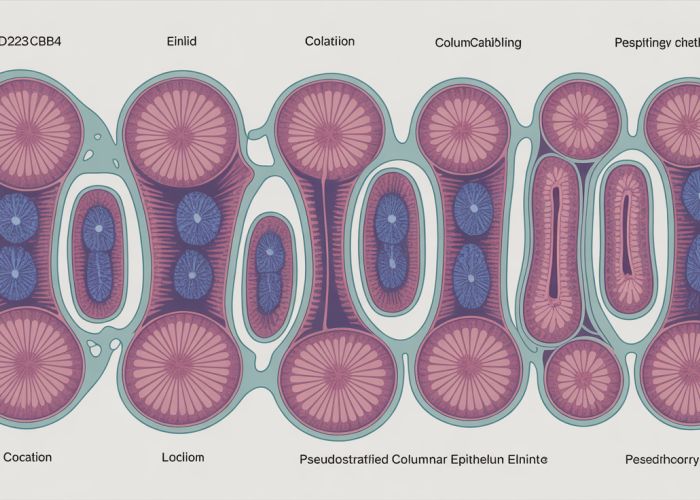Understanding the complexity of epithelial tissues often begins with recognizing the significance of **pseudostratified epithelium**. One crucial aspect is pseudostratified epithelium location. Typically found in the trachea, this unique cellular arrangement also plays a role in the male reproductive system. The microscopic observation of cellular structures at a location is essential in determining how it functions. Furthermore, the study of pseudostratified epithelium location benefits from the resources and insights offered by organizations like the National Institutes of Health (NIH).

Optimizing Article Layout for "Pseudostratified Epithelium Location: The Ultimate Guide"
The most effective layout for an article focusing on "pseudostratified epithelium location" should prioritize clarity, comprehensiveness, and easy navigation. It must guide the reader from a foundational understanding of the tissue to specific locations and their functional significance.
I. Introduction: Defining Pseudostratified Epithelium
This section should immediately establish what pseudostratified epithelium is.
- Begin with a concise and accessible definition. Avoid overly technical language.
- Include a visual aid, such as a labelled diagram or micrograph, illustrating the key characteristics:
- Apparent layering of nuclei.
- Cells touching the basement membrane.
- Varied cell shapes and sizes.
- Briefly highlight the two main types:
- Ciliated pseudostratified columnar epithelium.
- Pseudostratified columnar epithelium (non-ciliated).
- Mention the article’s scope: a detailed exploration of where these tissues are found and why.
II. Ciliated Pseudostratified Columnar Epithelium Location
This section delves into the primary locations of the ciliated variant.
A. Respiratory Tract
This subsection will cover the most prominent location.
- Nasal Cavity:
- Describe its role in filtering and humidifying air.
- Explain how the cilia and mucus work together to trap debris.
- Trachea:
- Detail the structure of the tracheal wall, emphasizing the location of the epithelium.
- Illustrate the "mucociliary escalator" mechanism.
- Bronchi:
- Explain the continuation of the ciliated epithelium lining into the larger bronchi.
- Mention the gradual transition to other epithelial types in smaller bronchioles.
B. Male Reproductive Tract (Specifically, Epididymis)
This is a less common, but important location.
- Describe the epididymis’ role in sperm maturation.
- Explain the function of stereocilia (long, immotile microvilli) in absorbing fluid and nutrients for sperm development.
- Include a visual aid highlighting the stereocilia.
III. Non-Ciliated Pseudostratified Columnar Epithelium Location
This section explores the location of the non-ciliated form.
A. Male Reproductive Tract (Specifically, Ductus Deferens)
This section highlights a major location for the non-ciliated form.
- Describe the ductus deferens’ function in transporting sperm.
- Explain how the lack of cilia is compensated by peristaltic contractions of the muscular wall to move sperm.
B. Larger Ducts of Some Glands
This is a less common, but still relevant location.
- Provide examples of glands where this type of epithelium might be found in their ducts (e.g., parotid gland ducts).
- Explain its function in these ducts, often related to secretion or protection.
-
Consider a table summarizing the information:
Location Type of Pseudostratified Epithelium Primary Function Key Features Trachea Ciliated Mucociliary clearance Cilia, goblet cells Epididymis Ciliated (with stereocilia) Sperm maturation Stereocilia Ductus Deferens Non-ciliated Sperm transport Muscular wall for peristalsis Parotid Gland Ducts (Example) Non-ciliated Secretion, protection (Specific to the gland and duct function)
IV. Comparative Analysis: Ciliated vs. Non-Ciliated
This section helps to solidify understanding through comparison.
- Create a table or bulleted list explicitly contrasting the two types based on:
- Typical Locations
- Primary Functions
- Key Structural Differences
- Explain the functional reasons why one type is found in a particular location and the other is not. For example:
- Cilia are essential for clearing debris in the respiratory tract.
- Stereocilia are important for absorption in the epididymis.
- Peristalsis is sufficient for sperm transport in the ductus deferens.
V. Potential Pathologies and Clinical Significance
This section adds real-world relevance.
- Discuss conditions that can affect pseudostratified epithelium, such as:
- Cystic fibrosis (affects mucus production and ciliary function).
- Primary ciliary dyskinesia (impairs ciliary movement).
- Metaplasia (transformation of one cell type to another) due to smoking or other irritants.
- Explain how understanding the location and function of this epithelium is crucial for diagnosing and treating these conditions.
FAQs About Pseudostratified Epithelium Location
Here are some common questions regarding the location and function of pseudostratified epithelium.
Where is pseudostratified ciliated columnar epithelium typically found?
The most common pseudostratified epithelium location is the lining of the respiratory tract. This includes the trachea and most of the upper respiratory system.
Why is pseudostratified epithelium often found in the respiratory tract?
Pseudostratified ciliated columnar epithelium plays a crucial role in trapping and removing debris from the respiratory system. The cilia beat in a coordinated manner to move mucus containing trapped particles upwards, away from the lungs. This mechanism is important, so the pseudostratified epithelium location supports it.
Does pseudostratified epithelium always have cilia?
No, not always. While pseudostratified ciliated columnar epithelium is most common, especially in the respiratory tract, there’s also pseudostratified columnar epithelium without cilia. The specific pseudostratified epithelium location determines whether cilia are present.
Besides the respiratory tract, where else can pseudostratified epithelium be found?
While less common, pseudostratified epithelium can also be found in the male reproductive system, specifically in the epididymis and parts of the vas deferens. In these locations, it often has stereocilia rather than cilia. Pseudostratified epithelium location in these areas supports the transport of sperm.
So, whether you’re a seasoned scientist or just starting to learn about histology, keep exploring the fascinating world of cells! Hopefully, this guide has clarified where to find pseudostratified epithelium location. Happy studying!